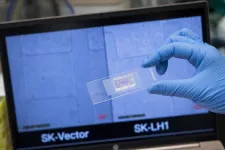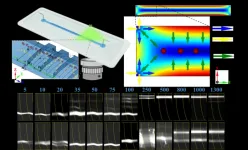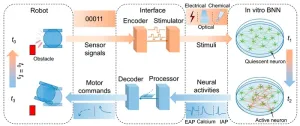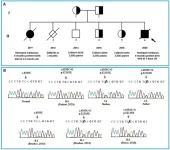Transporting antibodies across the blood–brain barrier to treat Alzheimer’s disease
2023-03-09
(Press-News.org)
Researchers led by Tokyo Medical and Dental University (TMDU) find that antibody fragments encapsulated in nanomicelles cross the blood–brain barrier and reduce the levels of toxic Aβ species in the brain of an Alzheimer’s disease model mouse
Tokyo, Japan — Sometimes the best things in life come by chance, when we happen to be in the right place at the right time. Now, researchers from Japan have found a way to ensure that new medications are delivered to the right place in the body and at the right timepoint in disease progression, so that they have the best effect.
In a study published recently in the Journal of Nanobiotechnology, researchers led by Tokyo Medical and Dental University (TMDU) have revealed that a novel delivery system delivers treatment to where it is needed most in a mouse model of Alzheimer’s disease (AD).
AD is a common neurodegenerative disease that causes dementia. It is characterized by the accumulation of a protein called amyloid β (Aβ) in the brain, and a number of different toxic forms of Aβ have been identified that impair brain function, notably Aβ oligomers (AβOs).
“Multiple clinical trials have attempted to use an anti-Aβ antibody to treat AD, but the results have been unsatisfactory,” says lead author of the study Akiko Amano. “One potential explanation for this is that the blood–brain barrier (BBB) prevents most full-length antibodies from entering the brain.”
To address this challenge, the researchers previously developed glucosylated (sugar-linked) polymeric nanomicelles (PMs), which are tiny, hollow balls that could successfully cross the BBB via transcytosis in mouse brain capillary endothelial cells; this process was mediated by glucose-transporter-1 and induced by an increase in blood glucose levels after the mice experienced fasting conditions. In this study, Takanori Yokota and colleagues filled PMs with fragments of an anti-AβO antibody, injected them into a mouse model of AD, and assessed the effects on the brain and on behavior.
“The results were very clear,” explains senior author Nobuo Sanjo. “Administration of anti-AβO antibody fragments through PMs significantly reduced the amounts of various toxic Aβ species. In addition, the Aβ plaques that did form were smaller and less dense than those seen in untreated mice.”
Next, the researchers analyzed the behavior of the mice and found that the mice treated with the antibody fragment-filled PMs had better learning and spatial memory than untreated mice. “Our findings suggest that delivering sufficient levels of antibodies to the brain using PMs can reduce toxic Aβ species and slow AD progression in mice,” says Amano.
Given that the failure of anti-Aβ antibodies to improve cognitive function in human clinical trials was likely because of an insufficient supply of the antibodies in the brain, PM-encapsulated antibody fragments could represent an effective way to prevent AD progression. In addition, new candidates for AD treatment that degrade toxic Aβs and reduce their toxic effects could also be delivered to the brain using the same PM-based system.
###
The article, “Peripheral administration of nanomicelle‑encapsulated anti‑Aβ oligomer fragment antibody reduces various toxic Aβ species in the brain,” was published in the Journal of Nanobiotechnology at DOI: 10.1186/s12951-023-01772-y
END
[Attachments] See images for this press release:
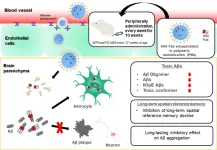
ELSE PRESS RELEASES FROM THIS DATE:
2023-03-09
CHICAGO – Today, the Species Survival Commission (SSC) of the International Union for Conservation of Nature (IUCN), the world’s largest conservation organization, announces that two iconic Chicago institutions - Shedd Aquarium and The Morton Arboretum - have been named as Centers for Species Survival. These new designations elevate the role of the Chicago region as an international leader in biodiversity conservation. What’s more, the two Centers will give the aquarium and the arboretum the opportunity to collaborate on conservation efforts, advancing projects that highlight the importance ...
2023-03-09
University of Virginia scientists have identified a promising approach to delay aging by detoxifying the body of glycerol and glyceraldehyde, harmful by-products of fat that naturally accumulate over time.
The new findings come from UVA researcher Eyleen Jorgelina O’Rourke, PhD, and her team, who are seeking to identify the mechanisms driving healthy aging and longevity. Their new work suggests a potential way to do so by reducing glycerol and glyceraldehyde’s health-draining effects.
“The discovery was unexpected. We went after a very well-supported hypothesis that the secret to longevity was the activation of a cell-rejuvenating ...
2023-03-09
WASHINGTON —In many baseball-obsessed countries like Korea, Japan and the United States, with spring months comes the start of the season and quite a few balls flying through the air. But it’s not just balls that can be thrown. On the tiniest field imaginable, scientists have now shown they can also throw and catch individual atoms using light.
This amazing feat was achieved with optical traps, which use a highly focused laser beam to hold and move tiny objects. Although optical traps have been used to move individual atoms before, this is the first time ...
2023-03-09
At this year’s American Academy of Orthopaedic Surgeons (AAOS) Annual Meeting, held March 7 to 11 in Las Vegas, Hospital for Special Surgery (HSS) presented new research on a variety of topics in orthopedic surgery, including studies related to minimally invasive surgery, racial disparities, and opioid alternatives for pain management in spine care.
What follows are some highlights from the meeting:
Intravenous versus Oral Administration of Acetaminophen Perioperative to Instrumented Lumbar Fusion: A Single-Center, Randomized Controlled Trial
In patients undergoing ...
2023-03-09
Cancer metastasis is a major cause of cancer-related death. A research team at City University of Hong Kong (CityU) recently identified a protein that triggers the migration of liver and pancreatic cancer cells and metastasis, and is correlated with shortening the survival time of patients. The research findings were verified by in vitro and in vivo models, supported with clinical data, and are expected to provide a new potential target for cancer therapy.
“Cancer metastasis is a complex process. Stiffness in tumours and the surrounding tissues is known to increase along with the tumour growth, which creates confined spaces or channel-like tracks of pores for tumour ...
2023-03-09
A research paper by scientists at the Hebei University of Technology and Shenzhen University developed an on-chip viscoelasticity sensor for biological fluids.
The new research paper, published on Jan. 10, 2023 in the journal Cyborg and Bionic Systems, reported a double-layered microfluidic sensor to detect the ultra-weak viscoelasticity in biological fluids.
“Most of human body fluids are non-Newtonian liquids, and the influence of viscoelasticity is often ignored for the sake of simplification of analysis. However, we ...
2023-03-09
A review paper by scientists at the Beijing Institute of Technology summarized recent efforts and future potentials in the use of in vitro biological neural networks (BNNs) for the realization of biological intelligence, with a focus on those related to robot intelligence.
The review paper, published on Jan. 10 in the journal Cyborg and Bionic Systems, provided an overview of 1) the underpinnings of intelligence presented in in vitro BNNs, such as memory and learning; 2) how these BNNs can be embodied with robots through bidirectional ...
2023-03-09
The American Society for Biochemistry and Molecular Biology today announced its 2023 class of fellows. The honorific program recognizes scientists who have made outstanding contributions to the field through their research, teaching, mentoring or other forms of service.
The society will recognize the 20 new fellows at its annual meeting, Discover BMB, later this month in Seattle. The presentation will be part of the society's presidential address and business meeting scheduled for Saturday, March 25.
“This group truly represents members who have ...
2023-03-09
Harlequin ichthyosis (HI) is a severe genetic skin disorder characterized by thick white, brown, or dark brown patches on the skin covering a newborn's entire body. HI has a low incidence of 1 per 300,000 live births but comes with the highest mortality rate among skin conditions. It is caused by a mutation in the ABCA12 gene, which codes for a protein involved in transporting lipids necessary for the formation of the skin barrier. Such protein shortage leads to a weaker epidermal barrier.
A recent study, co-authored by BGI Genomics Dr. Thomas Qiu, published in Frontiers in Pediatrics covers ...
2023-03-09
Like poles support a tent, microtubules—hollow cylindrical structures made of tubulin protein—support eukaryotic cells. But microtubules provide more than just mechanical strength; they help prepare the cell for cell division and migration and work as a railway track on which motor proteins transport materials within the cell. The formation of microtubules within cells resembles how a child assembles a Lego train track. The tubulins—Lego bricks—constantly assemble and disassemble to make the microtubule—train track—longer and shorter in processes called polymerization and depolymerization. The processes are regulated by microtubule-associated proteins such ...
LAST 30 PRESS RELEASES:
[Press-News.org] Transporting antibodies across the blood–brain barrier to treat Alzheimer’s disease




